Rod Brown has long been an influential player on the Australian showjumping scene. As a rider, he captained the Australian Showjumping Team to New Zealand in 1988 and he rode Slinky at the Seoul Olympics in 1998. Rod was a member of Australian Team won the Nations Cup at Kiskunhalis Hungary in 1991 on Spectre and the Australian Champion on Spirit in 1993 at Sydney Royal at night under lights over a very big Linda Allen course.
In 2006 Rod won five of the six Selection Classes for WEG including Australian Championships at Sale on Mr Burns, who he took to the WEG at Aachen.
As a coach, he has helped riders all over the country has been the Australian team coach for the 1990 WEG in Stockholm, and again at the 2010 WEG in Kentucky: “That was a real highlight,” says Rod, “On two levels – as a team we were so close to getting a medal and also seeing Chris Chugg, who I have worked with for 20 years, do so well on the Australian produced horse Vivant.
As a breeder, Rod – with his wife, Cathy who is an equally assiduous student of bloodlines – he has been one of the pioneers, using imported frozen semen over proven jumpers, and has now gone the next step, importing the beautifully bred, Higgins (by Heraldik xx, out of a For Pleasure mare).
Rod, Jess and Cathy
Rod and Cathy have also produced a prodigiously talented daughter, Jess, and recently Rod and Jess traveled to Europe and came back with Casco (by Cassini I out of a Corrado mare), to help Jess as she makes her way into Grand Prix ranks. Jess was riding Casco when we visited the Browns, at Equus Australia in Kulnurra on Sydney’s North Coast in late 2013.
Jess admits that Casco was a bit of an ‘out there’ choice:
“We were looking for a horse that was probably not a Grand Prix horse, but something that was soon going to be at that level. A horse that could help me get to that level. He wasn’t the typical horse that you would go overseas to buy. He has a bit of a tricky mouth, he goes in an open frame, and most people wouldn’t be attracted by that but he gives you a really good feeling, he has a great canter, and he is brave and careful.”
You just jumped your first Grand Prix track with him?
“On the weekend, that’s the biggest track he’s ever jumped and it felt really really good. It gave me a feeling that he will jump bigger tracks really easily. We were clear in the second round, which was bigger. So this year, hopefully he’ll keep stepping up into the Grand Prix classes, and maybe the World Cups by the end of the year, we’ll just see how he goes.”
Given his background as a serious breeder of jumping horses, Rod is a little less than enthusiastic about having to go OS to buy one, but says it was necessary:
“I think the breeding is getting better here, and I think we’ve got a couple of very good home-bred horses, but it is going to be another year or two before if they are good enough, they are going to get there, that’s why I went and bought one because I wanted Jess to get the feeling on a bigger canter, and the experience of jumping some bigger tracks. As it has turned out, Echo, one of the ones we bred, is just coming up in leaps-and-bounds, and he won’t be too far behind the grey horse… I couldn’t find one here in this country to buy for the same money I paid for the grey horse, a horse with the quality I wanted.”
Is it because there is a much bigger market and population of horses in Europe?
“Yes, and if someone has a nice horse here, the sort of horse I would want for Jess, they either don’t want to sell it, fair enough, or they want an over-the-top price for it, where I could go there and buy one as nice, if not nicer, and you are not talking hundreds of thousands. If the horse had been here in Australia, I would have had to pay at least as much, if not more.”
We’ve been looking at the breeding thing for 20 or so years now, and it has taken a while to mature, do you think it is only now that we are getting a mare base that can sustain a proper breeding exercise?
“Yes. In the early days of the breeding, even though they were using good stallions, we didn’t have the mares. Now with the breeding program in Australia, there are a lot more half decently bred mares. Look at the Oaks horses, Alice Cameron has some nice mares now. I think it takes a long time to learn what bloodlines cross with what bloodlines – the European breeders have been doing it for generations and they seem to know which cross is going to give you the better result.”
Still as soon as we arrived, Rod was keen to show us three youngsters by the resident stallion, Higgins, and they were attractive young horses:
“They are very pleasing to the eye, great temperament, they look like they can jump, we haven’t jumped them much, they are only two but they all look to have good techniques and be very willing, just straight into it. Before we put them out, we popped them under saddle over a little jump, and they just went to it.”
Cathy and two youngsters by Higgins
Do you have a feeling for what sort of mares Higgins is going to need?
“Not really. Our mares were ones we’d bred, two Lux mares and the Calvaro mare, but I know Tarsha Hammond put him to a Thoroughbred mare, and they say the foal is fantastic, they love it. I think he is going to be very versatile, he is Thoroughbred enough in the type to put to a big heavy mare and get a nice horse, and to a Thoroughbred, I think he’ll produce the Thoroughbred type with bone. I think he’ll be quite versatile with what mares go to him.”
I’ve said it before, but the problem with real trainers is that there are no gimmicks, no amazing exercises, just consistent, thoughtful riding, and Jess and Casco are doing all those boring, simple, essential things, as Jess explains:
“Casco can be a little heavy in the hand, so I was trying to move him forward and back, a few transitions, get him off the forehand and a bit more active from behind.”
“The exercises I use to get him a bit more engaged include shoulder-in, shoulder fore, forward/back, half halts, walk to canter, moving him off my leg rather than controlling him with my hands.”
Is it hard every day to keep that level of concentration?
“It’s not hard to keep doing it, but you have to be at yourself to keep focused – rather than just getting on the horse and trotting and cantering, you get nothing from that.”
Is it harder here in Australia than for the riders in Europe, where there are a whole lot of them working together, so the pressure is on to ride well?
“I suppose I am very lucky to have Dad here most of the time, and if I am slacking off a bit, he gets up me, but it is harder here where we don’t have all the riders to watch, something to aim to.”
Rod says that he has always realized how important good flatwork is:
“It has always been my way. Possibly when I was younger I was more enthusiastic about jumping them, but in general, I want them to travel and I have always worked on that, and Jess just follows suit, she just does it, that’s what she wants to do as well. My philosophy has always been getting them listening to you, responding to you on the flat, once you have done that, the jump is just a natural progression.”
“It depends on the horse, when we are in competition season, we might jump the horse twice a week, we might jump it once a week, depending on what happened at the previous show, does it need a bit more of this or that? I don’t have many pupils who come in, just a few, and the same with them, I make them do flat and some of them don’t come back because it is too boring. But the ones who come back, they are happy if I don’t even jump them.’
“The same when I do the clinics, you have only so much time with the group and quite often on the first day I’ll go way over time because I am not happy for them to go jumping until they have some understanding of how to make the horse travel, so usually on the first day of a clinic, I go way over time, which doesn’t worry me, but sometimes the second group is sitting on their horses for half an hour waiting…”
“It’s the same in Japan, I’ve just been over there for a six day clinic. Of course I’m not going to jump the guts out of them for six days, so I spend quite a lot of time on the flat, and over poles, little exercises, that’s the way I do it and my students have to accept that.”
It has changed hasn’t it, I was recently at one of George Morris’ clinics and really, especially our younger riders, they ride with a lot of style…
“Most of them have been trained. Our generation has become teachers, but when I was a young rider, the older generation didn’t want to know about teaching, or weren’t capable of teaching, they just jumped horses. The only one was Art Uytendaal, who was like my mentor without being my mentor, I used to watch and idolize him. He was different, it was what I always had in my head but I had never seen anyone ride like that before. So he had a big influence on me.”
He rode in a quiet classical style?
“It looked classical because the horses traveled rounder and they were more together, it just looked a different picture. Thinking back, he probably wasn’t as stylish as we thought he was, but he was European and he had the horses in a good shape. Actually his lower leg used to fly quite a bit, he’d pinch with his knee and the leg went back, but in every other way, the appearance was classy.”
Were there any other influences?
“I spent a bit of time with Harry Sanna, and when you spend time with people things rub off. He taught me a bit of the sideways stuff, shoulder in and all that.”
George Morris?
“Of course. What George really did for me was reinforce pretty well what I already thought. I believed I thought a little differently from most other jumping riders and the very first time I did the clinic with George, that’s what hit me the most. Not that I didn’t learn anything, I learnt a lot but the big part of it, the surprise, was how much I thought like him before I ever met him.”
The emphasis on the flat?
“The whole philosophy of riding, the flatting, the presentation of it, the stylish jump, all those things. Each time he comes I learn more, but particularly the last time he came, I thought that was his best clinic. Those early couple of clinics, and this last clinic, were the best. This time was the first time I’ve heard him say – you must not interfere with the shape of the jump in the air – and I thought, fantastic, that’s what I’ve been wanting to hear him say. He has probably always thought it, but he never emphasized that. This last clinic was fantastic, much more jumping orientated, even with the lower groups, than he ever was in the first few clinics.”
Of the European riders, are there any you look at hard, that give you cause to think?
“Lots of them. I love Nick Skelton’s riding – but its different, his is à la natural but he is a beautiful rider and horses always jump for him. There’s Marco Kutscher, heaps of them. When George comes here, he gets everyone to get into light seat, now if they were all leaning forward and hauling around, he’d be telling them to sit up. Anyone who does a clinic will emphasize what they see. The so-called American style and the European style, are not so different these days, but I think a combination of the two, a bit German, a bit American, is what our riders need.”
“This balance is a hard lesson to learn in riding, and I don’t think you get it until you truly feel it, or you become more experienced – the balance of leg to hand… They think because they’ve got the head down then everything is right, or they might be too forceful with their leg, and they wonder why the horse is arguing, that balance is something that is very difficult to teach until they find it. I think Jess is just starting to feel that, and she has been told and told and told and told… you really have to feel it to know what it is like.”
“The young boy working here now, he is so intent on getting the horse’s head down, he’s got the makings of a good rider, but he hasn’t yet found that balance, it is starting to come but it is hard to break the habits…”
When did you feel it?
“I think I always felt it… I don’t know. I can remember when I was young, I always wanted the mouth to be nice and soft, and even when no-one had taught me anything, I was never happy with a horse looking up in the air and dagging along even as a kid. I was probably pulling their heads down, but I don’t think so, but then I didn’t have many lessons when I was a kid. Just Pony Club. I was at a good Pony Club, Dandenong Ranges, and there was some quite nice help there: Mary Williamson, Jess Tomlison, Lee Gilbert. I was in the bottom group, on a coloured horse, either in a stock saddle or a racing pad, I didn’t have anything else, and they used to say to us, push your horse. That didn’t make any sense, what’s this push thing? Lee Gilbert took us, and she could see that we didn’t quite get this push thing and she said imagine you are sitting on a huge tube of toothpaste, and with your leg you are pushing the toothpaste forward and the reins are attached to the lid, and you keep the lid on, if you push too hard you’ll let some out. That really made sense to me…”
And Rod applies the same logic to Jess’s schooling:
“Normally what I try to do is to encourage her to keep the horse in front of her leg, to keep him active but nice. The last couple of months I’ve been getting her to do a little bit of shoulder in in the canter, getting him active behind. That horse needs to be active to produce his jump. Last week I was away in Japan and didn’t see her ride at the show, but Jess said to me, he felt much more active and she was able to have him much more forward, and I saw the video, he jumped really well.”
“Here we flat more than we jump. When I am here and not doing a clinic somewhere, pretty well I am on the arena every day watching Jess, and the people who work for us, ride, and they have a lesson every day.”
Jess admits that the father / daughter thing has caused the occasional disagreement:
“Ohhhh sometimes it’s an issue, we’ve been through some times, but I think I find it easier now, I’m understanding things better, and I listen to him a lot more.”
And as Jess found, working in Canada, good riding is the same the world over:
“I was in Canada for five months, I was in a good stable there, so I was around good riders and we went to good shows. There were a lot of riders very similar to the ones in Australia, but there were a lot more at the very high standard, a lot more riders jumping bigger tracks, a lot more advanced horses.”
Was the attitude to riding and training different?
“At the stable I was at, run by Jonothan Aslan, it was very much the same as here. My Dad teaches a lot of the same basics and training techniques. My Dad uses a lot of basics, we do a lot of work on the flat, it is never jumping, jumping, jumping, and when we do jump our horses are a lot more trainable and rideable.”
For Jess the goal is obvious:
“I’d love to go back overseas, maybe when we have a few more horses at a higher level, we’ll just have to see where they take us, but I would love to compete in Europe…”
For now she is still targeting domestic events; September’s Showcase of Showjumping in Sydney led to a promising start – a win in the Silver Tour with Echo and an unlucky third with Casco in the Gold Grand Prix. Unfortunately Casco then suffered a bruise in the Australian Showjumping Championships but was back on track for a good performance at the 2013 NSW Indoor Jumping Championships in Tamworth.
We wish Jess good luck on her campaign.
Jess and Casco jumping at the Aus Champs (Photo Derek O’Leary)
Rod Brown – Career highlights
Began riding in Melbourne, aged 13, started competing seriously at 18
Inspired by Dutch showjumper Art Uytendaal
With Slinky in Seoul, 1988
1988 Olympic Games Seoul, 10th place with the Australian team and 29th individual
1990 Coach to the Australian Team for Stockholm WEG
1991 Won the Nations Cup in Kiskunhalis, Hungary
1993 Crowned Australian Champion at Sydney Royal Show
2006 Won 5 of 6 selection classes for the WEG, including the Australian Championships in Sale
Mr Burns was his 2006 WEG mount
2006 Competed in the Aachen WEG, placing 16th with the Team
2010 Australian Team coach for Kentucky WEG



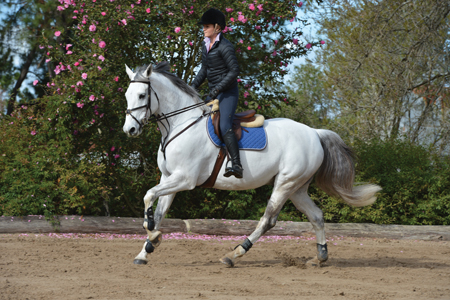
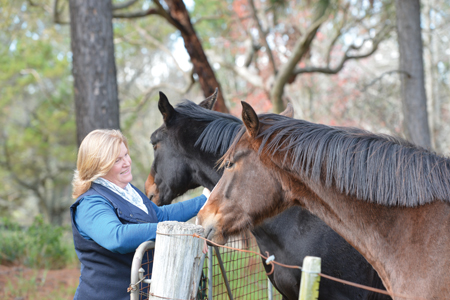
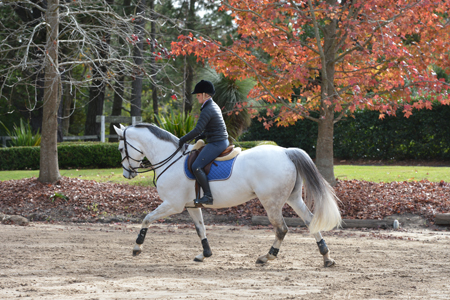
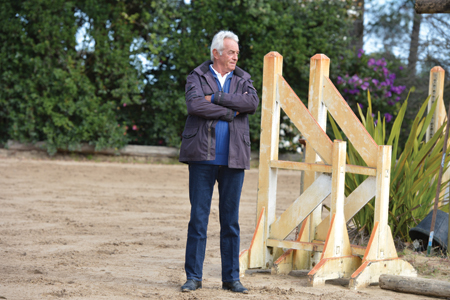
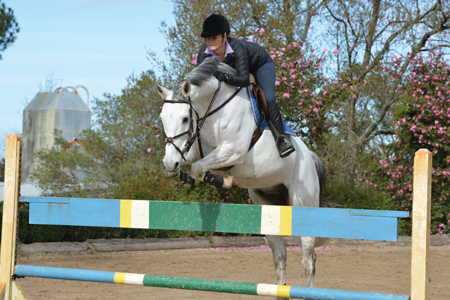
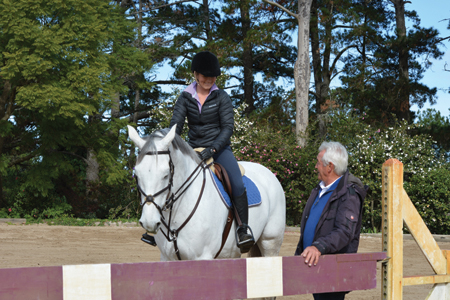
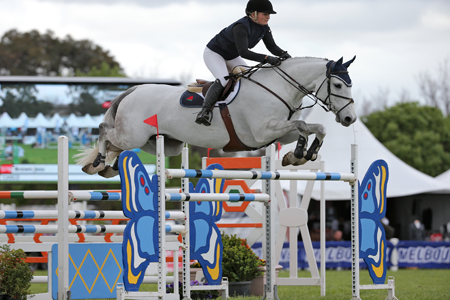
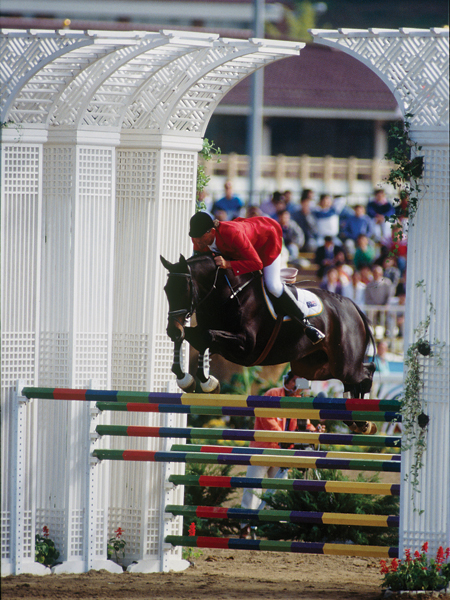
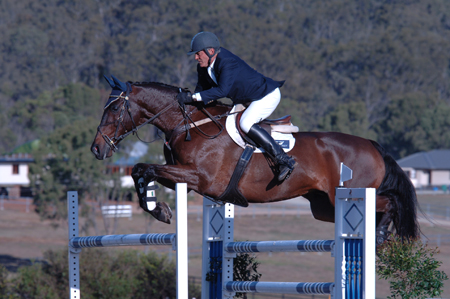
Kind regards Heinz